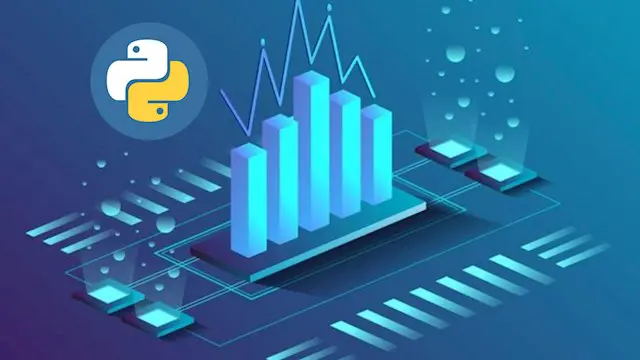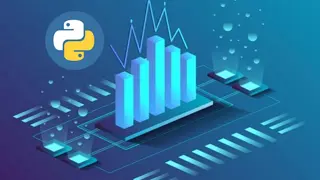
Data Visualisation in Python
Self-paced videos, Lifetime access, Study material, Certification prep, Technical support, Course Completion Certificate
Uplatz
Summary
- Certificate of completion - Free
- Reed courses certificate of completion - Free
Add to basket or enquire
Overview
Uplatz offers this detailed course on Data Visualisation with Python. It is a self-paced video course. You will be awarded Course Completion Certificate at the end of the course.
Data Visualization is the discipline of trying to understand data by placing it in a visual context so that patterns, trends and correlations that might not otherwise be detected can be exposed. Python offers multiple great graphing libraries that come packed with lots of different features.
"A picture is worth a thousand words." We are all familiar with this expression. It especially applies when trying to explain the insights obtained from the analysis of increasingly large datasets. Data visualization plays an essential role in the representation of both small and large-scale data. One of the key skills of a data scientist is the ability to tell a compelling story, visualizing data and findings in an approachable and stimulating way.
Data Visualisation with Python involves using Python programming language to build rich data visualizations and business intelligence or analytical reports. Python libraries such as Matplotlib and Seaborn are used to create rich visualizations.
Matplotlib is a comprehensive library for creating static, animated, and interactive visualizations in Python.
Seaborn is a Python data visualization library based on matplotlib. It provides a high-level interface for drawing attractive and informative statistical graphics.
In this Data Visualization in Python course by Uplatz, you will learn-
- You'll learn Matplotlib and Seaborn and have a solid understanding of how they are used in applied machine learning.
- You'll work through hands on labs that will test the skills you learned in the lessons.
- You'll learn all the Python vernacular specific to data visualization you need to take you skills to the next level.
- You'll be on your way to becoming a real world machine learning engineer or data engineer.
Curriculum
Course media
Description
Data Visualisation with Python – Course Syllabus
Introduction to Data Visualisation
- What is data visualization
- Benefits of data visualization
- Importance of data visualization
- Top Python Libraries for Data Visualization
Matplotlib
- Introduction to Matplotlib
- Install Matplotlib with pip
- Basic Plotting with Matplotlib
- Plotting two or more lines on the same plot
Numpy and Pandas
- What is numpy?
- Why use numpy?
- Installation of numpy
- Example of numpy
- What is a panda?
- Key features of pandas
- Python Pandas - Environment Setup
- Pandas – Data Structure with example
Data Visualisation tools
- Bar chart
- Histogram
- Pie Chart
More Data Visualisation tools
- Scatter Plot
- Area Plot
- Stacked Area Plot
- Box Plot
Advanced data Visualisation tools
- Waffle Chart
- Word Cloud
- HEAT MAP
Specialized data Visualisation tools (Part-I)
- Bubble charts
- Contour plots
- Quiver Plot
Specialized data Visualisation tools (Part-II)
- Three-Dimensional Plotting in Matplotlib
- 3D Line Plot
- 3D Scatter Plot
- 3D Contour Plot
- 3D Wireframe Plot
- 3D Surface Plot
Seaborn
- Introduction to seaborn
- Seaborn Functionalities
- Installing seaborn
- Different categories of plot in Seaborn
- Some basic plots using seaborn
Data Visualisation using Seaborn
- Strip Plot
- Swarm Plot
- Plotting Bivariate Distribution
- Scatter plot, Hexbin plot, KDE, Regplot
- Visualizing Pairwise Relationship
- Box plot, Violin Plots, Point Plot
Project on Data Visualisation using Python
Who is this course for?
Everyone
Requirements
Passion to achieve your goals!
Career path
- Data Visualization Analyst
- Data Visualization Developer
- Data Visualization Engineer
- Data Analyst
- Data Scientist
- Data Engineer
- MI Analyst
- Reporting Analyst
- Python Programmer
- BI Developer
- Data & Analytics Professional
- Data Consultant
Questions and answers
Currently there are no Q&As for this course. Be the first to ask a question.
Certificates
Certificate of completion
Digital certificate - Included
Course Completion Certificate by Uplatz
Reed courses certificate of completion
Digital certificate - Included
Will be downloadable when all lectures have been completed
Reviews
Currently there are no reviews for this course. Be the first to leave a review.
Legal information
This course is advertised on reed.co.uk by the Course Provider, whose terms and conditions apply. Purchases are made directly from the Course Provider, and as such, content and materials are supplied by the Course Provider directly. Reed is acting as agent and not reseller in relation to this course. Reed's only responsibility is to facilitate your payment for the course. It is your responsibility to review and agree to the Course Provider's terms and conditions and satisfy yourself as to the suitability of the course you intend to purchase. Reed will not have any responsibility for the content of the course and/or associated materials.


